This is a Brownie Starmatic made by the Eastman Kodak Company of Rochester, NY between the years of 1959 and 1963. It was the first Brownie camera to have both an exposure meter and automatic exposure. It is a simple, mostly plastic camera that used 127 roll film and took twelve 4cm x 4cm images per roll. The Starmatic was unusual in the Brownie family in that it offered modern conveniences like a meter, AE, and a triplet lens. It’s retail price of $34.50 was also unusually high for a Brownie. Despite the price, the Starmatic was popular and spawned a slightly revised Starmatic II in 1961.
Film Type: 127 Roll Film (twelve 4cm x 4cm exposures per roll)
Lens: 44mm f/8 Kodar uncoated 3-elements
Focus: Fixed Focus ~8 feet to Infinity
Viewfinder: Scale Focus with Auto Exposure Warning Indicator
Shutter: Rotary Metal Blade
Speeds: Instant ~1/40 second
Exposure Meter: Coupled Selenium Cell
Battery: None
Flash Mount: Screw in Kodak Supermite or Kodalite Midget Flash
Manual: https://mikeeckman.com/media/KodakBrownieStarmatic.pdf
History
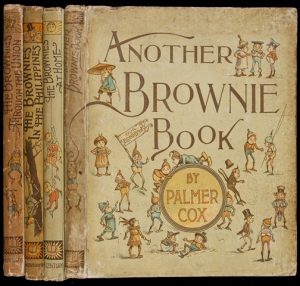
The Kodak Brownie was the name of a mind boggling number of inexpensive camera models manufactured by the Eastman Kodak Company starting with the original Brownie Camera from 1900 and lasting until the second half of the 20th century. The name ‘Brownie’ came from a series of animated characters known as ‘The Brownies’ by Canadian illustrator Palmer Cox. The Brownies were published in books and newspapers first in 1879, but became hugely popular throughout the remainder of the 1800s and into the early 20th Century.
The images of Brownies were used on Eastman’s packaging and advertisements for Brownie cameras, but according to Wikipedia, Cox was never paid any royalties for their use in Eastman’s products. Besides the Brownie camera, images of the Brownies were also used in a large variety of children’s games, dolls. books, and other products.
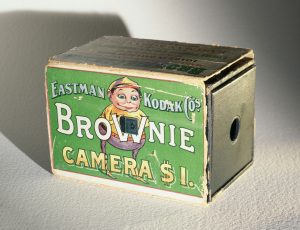
The Brownie camera was a very simple box camera that sold for $1 and used 117 roll film that cost 15 cents per roll. A year after it’s release, the original Brownie was improved and released as the No. 2 Brownie which used a new type of roll film, later known as type 120 film, which turned out to be the most popular form of roll film ever made, so much so that today in 2017, it is still made and used by photographers all over the world.
I won’t spend much more time discussing the history of the Brownie camera as there are already many great sites which already cover the many different models that were made. If you are interested, I recommend Remy Steller’s Brownie.Camera site, and Chuck Baker’s Brownie-Camera Page.
Over the course of the next several decades, a dizzying array of cameras would be produced and sold by Kodak with varying sizes, shapes and colors. Brownies would be produced that used 110, 116, 117, 120, 122, 124, 127, 130, 616, and 620 film. They would be made using cardboard, wood, metal, and several varieties of plastic. Although most were box cameras, there would be a few which were Twin Lens designs like a TLR. Despite this huge variation in Brownie cameras made over the years, one consistent theme was that they were all inexpensive and easy to use.
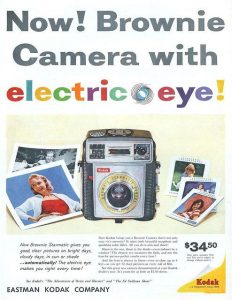
The Brownie Starmatic was no exception, mostly. With auto exposure and a triplet lens, the Starmatic was pretty high end for the Brownie lineup. So was it’s price. The Brownie Starmatic originally sold for $34.50 which although not unreasonable for an automatic camera for the time, was considerably higher than the $10 – $15 Brownies people were used to paying for. When adjusted for inflation, that is like $291 today. Imagine a product you were used to seeing being sold in the $50 – $100 range, and then all of a sudden a new model debuts for $291. It seems Kodak did a good job of convincing people to buy the camera as it was popular enough to spawn a Starmatic II which had a gray body cover and two manual speeds.
The Starmatic was the right camera at the right time as in 1959 when this camera debuted, five other models also debuted with automatic exposure. These six models have been referred to as the “AE Class of 1959”. In their November 1959 issue, Popular Photography reviewed these six cameras and declared their “electric eyes” to work well within the limitations of each model.
Take a look at the period commercial that attempts to prove why the Brownie Starmatic is an ideal for those precious moments with Susie!
Despite it’s appeal, the Starmatic was not in production for long. This had less to do with the merits of the camera, and more with the incredible speed camera technology was advancing at the time. In 1958 there were almost no cameras with automatic exposure, and less than 2 years later, there were at least 15. The marketplace exploded so quickly with inexpensive, easy to use AE cameras, that the place for the Starmatic was quickly filled by other, more capable models.
Today, nearly every collector likely has at least one Brownie in their collection, but the Starmatic usually isn’t it. I was aware of the various “Star” Brownies that used 127 film, but not the Starmatic until one fell in my lap. It is a handsome and very capable camera that is still usable today, even with a dead meter. I doubt anything I say here will inspire legions of people to seek out one for themselves, but I found the camera to be one of the more pleasant surprises I’ve encountered in my time with this hobby.
My Thoughts
Collecting cameras can be an exciting hobby. Any time you get to be known as “the guy (or gal) who likes old cameras”, people start to volunteer old cameras they find in their (grandparent/aunt/uncle/friend)’s (closet/attic/basement). Most of the time what they have is junk, yet you still feel obliged to smile and thank them for thinking of you as you quietly wonder what you’re going to do with this old Brownie that you inherited.
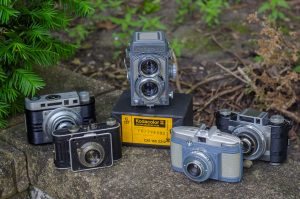
But sometimes, that old Brownie turns out to be something a lot more than you first expected it to be. Such is the case of this Brownie Starmatic. This one was gifted to me by a co-worker and my only interest of it at the time was the fact that it used 127 film instead of the more common 620 Brownies of the era. At the time I had an increased interest in 127 cameras like the Detrola Model E, Foth Derby, and Yashica 44. While this Starmatic pales in comparison to the impressive specs of those other 3 cameras, it was clean and looked worthy of at least a little bit of my time.
Once I took the time to research a little about the camera I had, I learned that this was the first Brownie capable of automatic exposure and at the time was the most expensive Brownie ever made. Furthermore, the manual for the Starmatic lists the lens as a triplet which suggests this is more than just the usual meniscus or doublet lenses that often appear in Brownies.
I was impressed not just with the inclusion of automatic exposure, but the ability to shoot the camera manually, as this was often not possible on many early “electric eye” cameras. This was immediately useful as the meter on this particular Starmatic was DOA when I received it. I played with the camera as I usually do, read what I could about it online and thought it to be a fun little diversion when I wanted to burn through a roll of 127.
The first thing you’ll likely notice when picking up the Brownie Starmatic is that it is compact and incredibly light weight. Weighing in at a mere 206 grams on my kitchen scale without film loaded, the Starmatic is the lightest camera in my collection. This is achieved by an almost entirely plastic construction. The flash terminals, strap lugs, film speed and EV dials, and a couple of screws are the only things made of metal. Even the lens is plastic.
Using the Starmatic is about as basic as you can get. Assuming you have a working light meter, you would leave the large dial on top to Auto and then turn the small dial to match your film speed. The camera natively supports speeds from 32 to 125 but using a film with good latitude, I would be willing to bet 200 and possibly even 400 speed film would work fine.
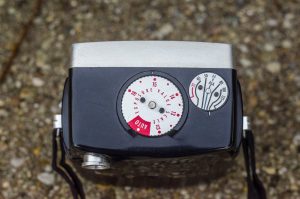
Since the meter on mine was dead, I had to use one of the 5 EV values, 12 through 16 to control exposure. The Starmatic has a single speed shutter which I could not find any information about, but my best guess is probably 1/40. The reason I think it might be 1/40 is that the later Starmatic II has a dual speed shutter that the manual lists as 1/40 and 1/80. My guess is the two cameras have the same shutter, with the later model achieving a faster 1/80 speed via a stronger spring.
The Starmatic does not have a traditional iris to control aperture like a more advanced camera, but has a diamond shaped plate that is separated into two halves. With the camera set to EV 12, the diamond is “wide open”. Choosing speeds 13 through 16, closes the diamond, limiting it’s ability to open all the way, thus restricting light. It’s a pretty basic setup, but it works remarkably well.
For my first roll, I chose some fresh Rerapan 127 that I had in laying around. Rerapan is a 100 speed film, so doing some exposure math in my head, I planned on shooting the camera on a partly sunny day, which is generally EV 14 on most scales, and even though the shutter is slower than a typical Sunny 16 formula would call for, I just left the camera at EV 15 for almost every shot figuring that the latitude of the Rerapan would compensate for the rest.
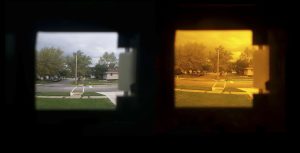
A neat little feature when using the camera in manual mode is that an amber colored mask moves in the way of the viewfinder, tinting your image. This was likely done as a “warning” to novice photographers to remind them that the camera was not in automatic mode. The amber coloring was not distracting, and in a way, kind of added to the uniqueness of shooting the Starmatic.
The Kodar f/8 lens has a focal length of 44mm which if this was a 35mm camera, would be a semi-wide angle lens. I found composing images through the viewfinder to be very easy as the semi-wide angle allowed me to get large buildings and whole scenes in the square finder without having to back up too much.
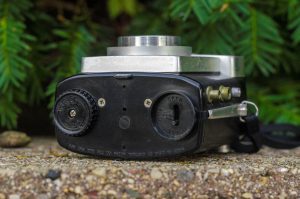
Loading film into the Starmatic requires removal of the film compartment which is located on the base of the camera. This system is very typical of many simple 127 cameras of the era like the Bell & Howell Electric Eye 127. On the bottom of the camera are two circular “feet”, one of which double as the film advance knob. Inside of this knob is a slider that locks and unlocks the film compartment. With this switch in the unlock position, the entire bottom of the camera pulls out.
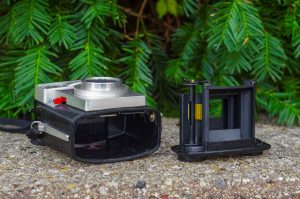
With the film compartment removed from the camera, you can easily see both the takeup and supply spools. Loading film into the Starmatic is very easy, unlike other 127 cameras that require pins to be pulled apart to reveal tiny little recesses for the spool to slide into. In the image to the left, the empty spool is on the supply side. The takeup side is empty as I had just finished a roll of film without moving the old supply spool to the other side in preparation for the next roll.
With a fresh roll of film installed, you need to turn the advance crank a couple of times to ensure the paper leader is securely attached to the spool, and then you slide the entire film compartment back into the camera, and lock the compartment with the lever on the bottom. Finally, you advance the film until you see the number 1 appear in the red window on the back of the camera. The camera will automatically cock the shutter while loading your first roll of film, so be careful not to accidentally press the shutter release while preparing for your first shot, or you may unintentionally waste an exposure!
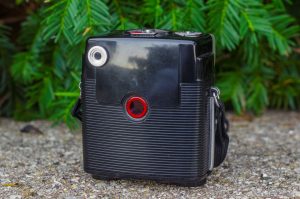
In addition to automatically cocking the shutter, the Starmatic also has Double Exposure Prevention which will not allow you to fire the shutter after taking an image without first advancing the film. You must still pay attention to the red window on the back of the camera and stop at the next number as the camera will allow you to wind past the next exposure if you aren’t careful.
With the camera ready for it’s next exposure, put it up to your eye, frame your shot, and then a gentle press of the red lever on the photographer’s right side of the camera will fire the shutter with a satisfying click.
There’s not much else to talk about in terms of using the camera. This is a Brownie after all, and it was designed to be as easy as possible. I generally enjoyed the experience during my first roll of film, but it almost seemed too easy. These images couldn’t possibly be any good from such a basic camera, could they?
My Results
I was cautiously optimistic before using the Starmatic so when deciding which film I would use, instead of a new old stock expired roll of film, I went for a fresh roll of Rerapan 127 I had. The benefit to this was not only would I be getting a fresh film that would likely show everything the Starmatic was capable of, but being black and white, I could develop it myself since I don’t do color.
I took the old Kodak with me on a partly sunny day in late September to Crown Point, Indiana and walked around their historic town center and snapped a variety of photos.
I probably don’t need to tell you that I was very happy with the quality of the images I got from the little Brownie. I expected them to be decent, but not like this. Not only was exposure nearly perfect, but the sharpness of the plastic triplet was incredible. Softness does creep in near the edges, but it’s unobtrusive and adds to the vintage look you might expect from a 1950s Kodak.
The shooting experience was quite pleasant. Although small, the viewfinder was easy to use, even with prescription glasses. I appreciated the semi wide angle 44mm view which allowed me to frame large buildings without having to stand really far away. In the images above of the Crown Point court houses, I am standing on the sidewalk in front of the building, and as you can see, I got quite a bit of the building in the frame.
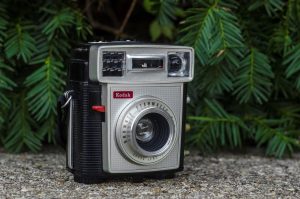
A curious anomaly that appeared in almost every shot was wavy lines which possibly suggests issues with film flatness. It is most noticeable in the second and third images in the gallery above of the building’s roof lines. I can’t explain why this happened as the images all appear to be sharply in focus which usually isn’t the case with film plane issues.
Regardless, I was very pleased with these images, and if these are indicative of what other Starmatics were capable of, I am sure that Susie’s Dad was very pleased with the slides that he likely took of his daughter in the commercial above!
Are there better examples of electric eye cameras? Of course. While I was extremely pleased with the results I got, I made every effort to work within the camera’s limitations. I purposely selected a film that I thought would work best with the camera’s single shutter speed. I could not have shot it indoors, or in poor lighting. Every shot is static, with nothing in motion, and I limited myself to objects 20 feet and more away so of course a more capable camera would have allowed me greater flexibility, but that’s OK. For what the Starmatic is, it works extremely well, and when used to it’s strengths, is a deceivingly capable little box! If a co-worker comes up to you and says they have a Brownie they found in their aunt’s closet, don’t immediately be disappointed as maybe you’ll get lucky and that Brownie will turn out to be a Brownie Starmatic!
My Final WordHow these ratings work |
The Kodak Brownie Starmatic was the first (and only) Brownie to have automatic exposure and upon it’s release was the most expensive camera to feature the Brownie name. It had a compact and easy to use body with an accurate meter and even offered limited manual control, which proves useful today if you find one with a dead meter. Contrary to other Brownies, the Starmatic features a 3-element lens that produces images with impressive sharpness and contrast across the image. While images from the Starmatic will ever be mistaken as those shot in a Baby Rolleiflex, the images are quite good. In use, the Brownie Starmatic is still very capable today. The minimum EV12 setting limits usage of this camera to outdoors only, but when used to it’s strengths, it is a very fun camera whose images will likely impress most collectors. | ||||||
| Images | Handling | Features | Viewfinder | Feel & Beauty | History | Age | |
| 2 | 2 | 0 | 1 | 1 | 1 | 20% | |
| Bonus | none | ||||||
| Final Score | 8.4 | ||||||
Additional Resources
http://www.brownie-camera.com/41.shtml
http://camera-wiki.org/wiki/Kodak_Brownie_Starmatic
http://camerapedia.wikia.com/wiki/Kodak_Brownie_Starmatic
https://blog.jimgrey.net/2012/08/09/shooting-my-kodak-brownie-starmatic/
https://blog.jimgrey.net/2011/01/24/kodak-brownie-starmatic/

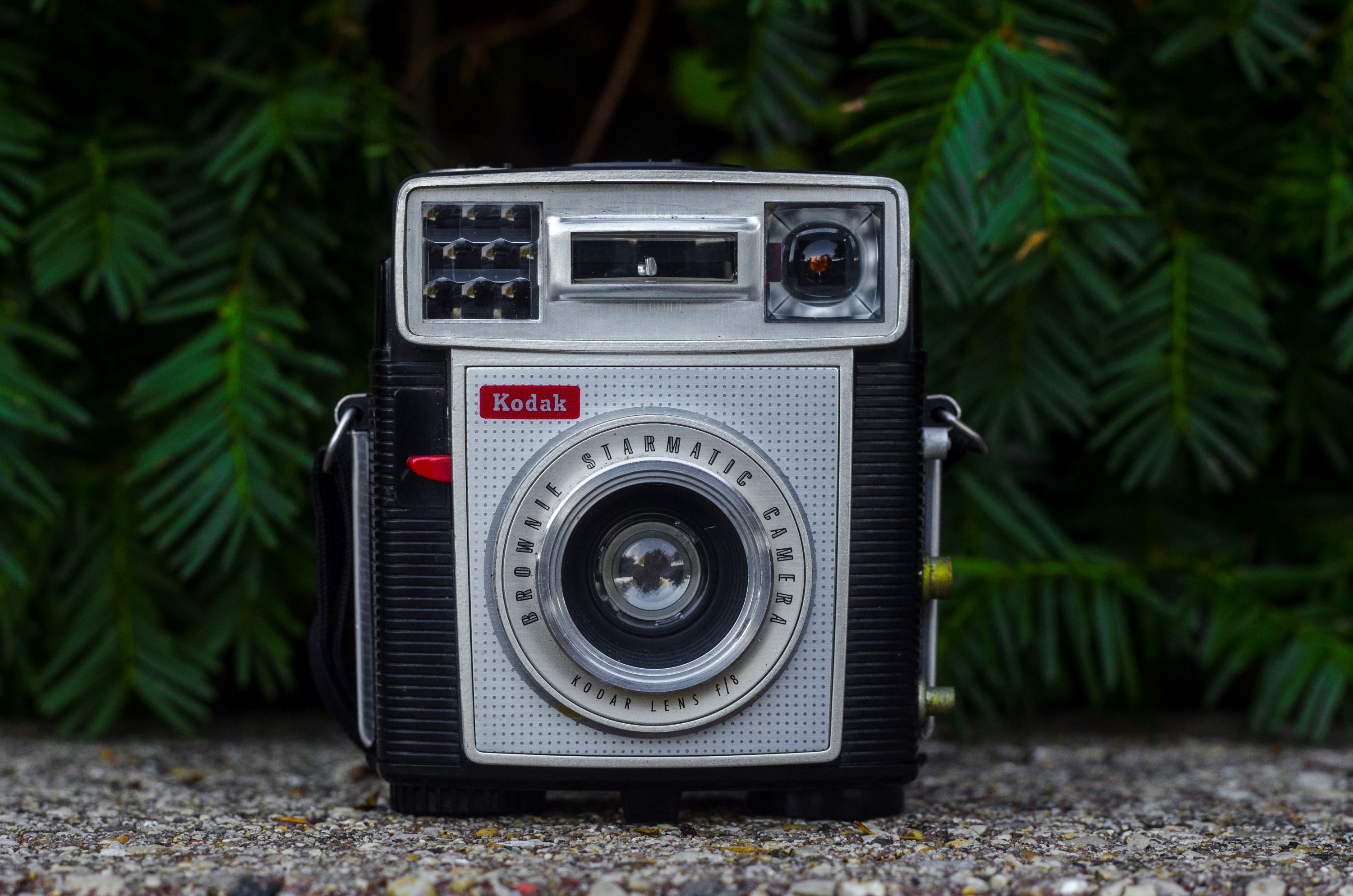
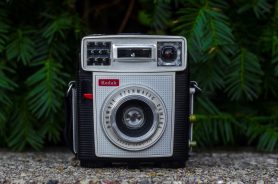









How did you know that your meter was dead? I just got one of these and I’m curious if it will work. I have some 400 iso film on the way, will that work? Should I keep it on 16 rather than try auto? Thank you for any help!